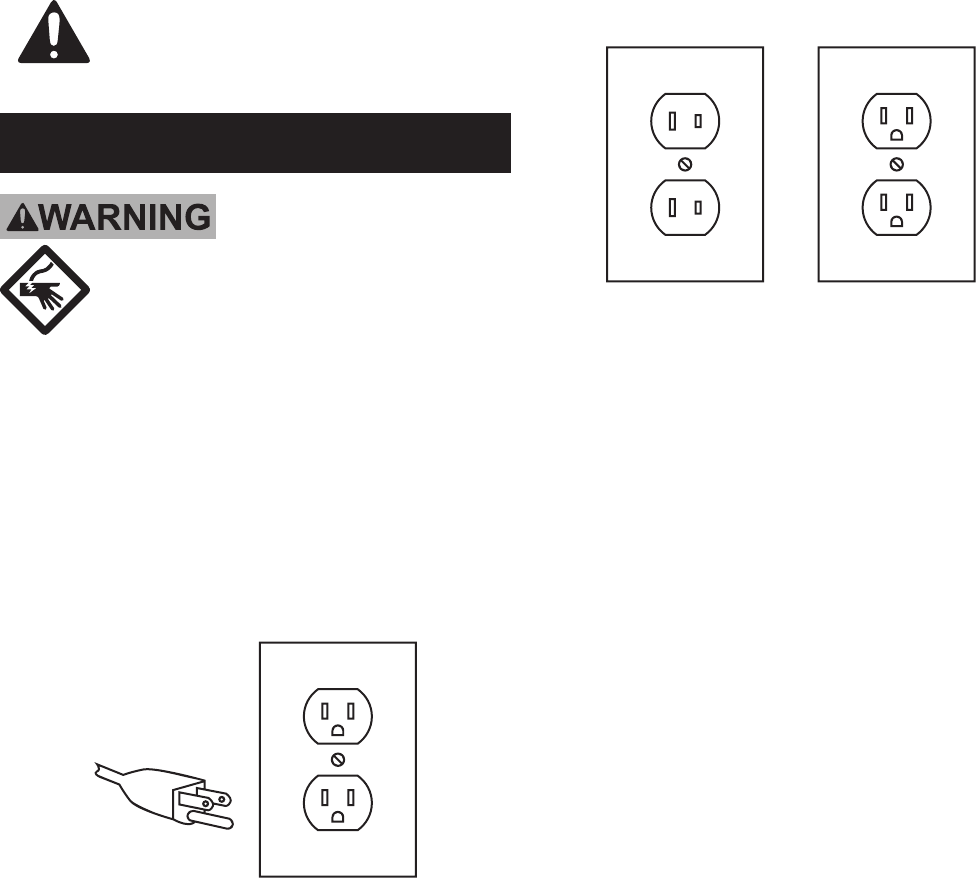
Page 5For technical questions, please call 1-800-444-3353.SKU 68341
2. Do not smoke during use. Nicotine reduces
the blood supply to the hands and ngers,
increasing the risk of vibration-related injury.
3. Wear suitable gloves to reduce the
vibration effects on the user.
4. Use tools with the lowest vibration
when there is a choice.
5. Include vibration-free periods each day of work.
6. Grip tool as lightly as possible (while still keeping
safe control of it). Let the tool do the work.
7. To reduce vibration, maintain the tool as
explained in this manual. If any abnormal
vibration occurs, stop use immediately.
SAVE THESE
INSTRUCTIONS.
Grounding
TO PREVENT ELECTRIC SHOCK AND
DEATH FROM INCORRECT GROUNDING
WIRE CONNECTION:
Check with a qualied electrician if you are
in doubt as to whether the outlet is properly
grounded. Do not modify the power cord plug
provided with the tool. Never remove the grounding
prong from the plug. Do not use the tool if the power
cord or plug is damaged. If damaged, have it
repaired by a service facility before use. If the plug
will not t the outlet, have a proper outlet installed by
a qualied electrician.
Grounded Tools:
Tools with Three Prong Plugs
3-Prong Plug and Outlet
1. Tools marked with “Grounding Required” have a three
wire cord and three prong grounding plug. The plug
must be connected to a properly grounded outlet.
If the tool should electrically malfunction or break
down, grounding provides a low resistance path to
carry electricity away from the user, reducing the risk
of electric shock. (See 3-Prong Plug and Outlet.)
2. The grounding prong in the plug is connected through
the green wire inside the cord to the grounding
system in the tool. The green wire in the cord must
be the only wire connected to the tool’s grounding
system and must never be attached to an electrically
“live” terminal. (See 3-Prong Plug and Outlet.)
3. The tool must be plugged into an appropriate outlet,
properly installed and grounded in accordance with
all codes and ordinances. The plug and outlet should
look like those in the preceding illustration.
(See 3-Prong Plug and Outlet.)
Double Insulated Tools:
Tools with Two Prong Plugs
Outlets for 2-Prong Plug
1. Tools marked “Double Insulated” do not
require grounding. They have a special
double insulation system which satises
OSHA requirements and complies with
the applicable standards of Underwriters
Laboratories, Inc., the Canadian Standard
Association, and the National Electrical Code.
2. Double insulated tools may be used in either of the
120 volt outlets shown in the preceding illustration.
(See Outlets for 2-Prong Plug.)
Extension Cords
1. Grounded tools require a three wire extension
cord. Double Insulated tools can use either
a two or three wire extension cord.
2. As the distance from the supply outlet increases,
you must use a heavier gauge extension
cord. Using extension cords with inadequately
sized wire causes a serious drop in voltage,
resulting in loss of power and possible tool
damage. (See Table A on page 6.)
3. The smaller the gauge number of the wire, the
greater the capacity of the cord. For example,
a 14 gauge cord can carry a higher current
than a 16 gauge cord. (See Table A.)
















